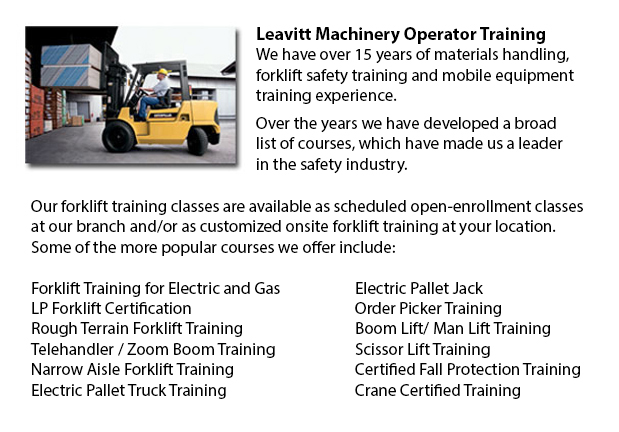
Pallet Stackers Training Oakville - A pallet stacker is a type of pallet jack that is utilized to transfer, stack and haul palletized produce that are too difficult for manual lifting. Its key purpose is to load and unload pallets on trucks, in addition to transferring pallets to and from a variety of places within a stockroom space or stockroom. On the whole pallet stackers are constructed of heavy duty materials to withstand tremendous weights. Pallet stackers are often identified as pallet jacks. They may be operated from a seated, upright or walk-behind position. Pallet jacks are divided into manual and powered varieties.
Certain basic components comprise the pallet stacker. There are forks that slide beneath a pallet, capable of transporting and raising it to a preferred height. The engine section or casing houses the gas-run, electronic or hydraulic equipment that powers the machine.
Normally, pallet stackers come in walk-behind models that are hand-powered. This means that they are moved by pushing and pulling the jack into its preferred location, while lifting the heavy pallets can be operated hydraulically making this chore a great deal easier. Using a foot pedal or handle raises the stacker's forks. Squeezing a lever or trigger returns the forks to the floor. These types of pallet jacks are ideal for lighter loads of up to approximately 1 ton or 907.18 kg.
Electric or gas driven pallet jacks can accommodate extreme lifting weights of up to 5 tons or 4535.92 kg. They are physically less demanding than the manual designs due to the mechanized power to raise and lower the stacker's forks. These models are steered by rotating the handle in a particular direction. There is a button on the handle that functions to raise and lower the forks. A throttle set up on the stacker's grips moves the appliance forward and in reverse. This type of equipment is generally known as a forklift and is used from a sit-down posture.
Picking the correct version of pallet stacker can be somewhat important as machines will have varying lift functionality, along with varying fork widths. Some versions of stackers may only allow two pallets to be loaded at one time, while other versions might be able to stack several pallets. Certain versions of these forklifts feature an changeable fork in order to permit the stacker to slide under pallets of unusual sizes and shapes. These designs are effective when a mixture of kinds of pallets are used within a workspace.
-
JLG Telehandler
JLG Telehandler Training Oakville - Following retirement in the late 1960's, John L. Grove started on a cross country RV expedition. After spending numerous years establishing his family built crane business with his brother, John had no idea that th... More -
Doosan Forklift
Doosan Forklift Training Oakville - Doosan Infracore Company Ltd. is a transnational organization consisting of Diesel Engines, Defense Industry goods, Industrial Vehicles, Construction Technologies and Machine Tools and Computerization Systems.... More -
Genie Forklift
Genie Forklift Training Oakville - Genie is a universally established company that enjoys the spirit of alliance with their vast network of connected consumers. Genie Industries prides itself on the idea of bringing materials and people higher and ex... More -
Scissor Lifts
Scissor Lift Training Oakville - The scissor lift, often identified as a table lift, is an industrialized lift that has been tailored for use within wholesale and retail settings. Industrial platform lifts have been utilized for decades in the manufa... More -
Komatsu Forklift
Komatsu Forklift Training Oakville - Komatsu Forklift U.S.A. Inc. has a very good reputation for building reliable and robust lift trucks. Komatsu is recognized around the globe as a corporation with a prosperous heritage while maintaining an admirab... More

Forklift Training Oakville
TOLL FREE: 1-888-254-6157
Oakville, Ontario
forklifttrainingoakville.com
Email Us
About Us


